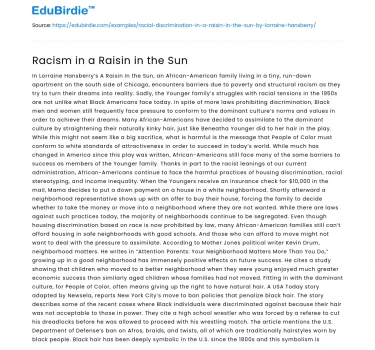In Lorraine Hansberry’s A Raisin In the Sun, an African-American family living in a tiny, run-down apartment on the south side of Chicago, encounters barriers due to poverty and structural racism as they try to turn their dreams into reality. Sadly, the Younger family’s struggles with racial tensions in the 1950s are not unlike what Black Americans face today. In spite of more laws prohibiting discrimination, Black men and women still frequently face pressure to conform to the dominant culture’s norms and values in order to achieve their dreams. Many African-Americans have decided to assimilate to the dominant culture by straightening their naturally kinky hair, just like Beneatha Younger did to her hair in the play. While this might not seem like a big sacrifice, what is harmful is the message that People of Color must conform to white standards of attractiveness in order to succeed in today’s world. While much has changed in America since this play was written, African-Americans still face many of the same barriers to success as members of the Younger family. Thanks in part to the racist leanings of our current administration, African-Americans continue to face the harmful practices of housing discrimination, racial stereotyping, and income inequality.
When the Youngers receive an insurance check for $10,000 in the mail, Mama decides to put a down payment on a house in a white neighborhood. Shortly afterward a neighborhood representative shows up with an offer to buy their house, forcing the family to decide whether to take the money or move into a neighborhood where they are not wanted. While there are laws against such practices today, the majority of neighborhoods continue to be segregated. Even though housing discrimination based on race is now prohibited by law, many African-American families still can’t afford housing in safe neighborhoods with good schools. And those who can afford to move might not want to deal with the pressure to assimilate.
Save your time!
We can take care of your essay
- Proper editing and formatting
- Free revision, title page, and bibliography
- Flexible prices and money-back guarantee
According to Mother Jones political writer Kevin Drum, neighborhood matters. He writes in “Attention Parents: Your Neighborhood Matters More Than You Do,” growing up in a good neighborhood has immensely positive effects on future success. He cites a study showing that children who moved to a better neighborhood when they were young enjoyed much greater economic success than similarly aged children whose families had not moved.
Fitting in with the dominant culture, for People of Color, often means giving up the right to have natural hair. A USA Today story adapted by Newsela, reports New York City’s move to ban policies that penalize black hair. The story describes some of the recent cases where Black individuals were discriminated against because their hair was not acceptable to those in power. They cite a high school wrestler who was forced by a referee to cut his dreadlocks before he was allowed to proceed with his wrestling match. The article mentions the U.S. Department of Defense’s ban on Afros, braids, and twists, all of which are traditionally hairstyles worn by black people. Black hair has been deeply symbolic in the U.S. since the 1800s and this symbolism is employed in the play. Because Beneatha Younger straightens her hair, her Nigerian friend Joseph Asagai, who doesn’t believe in assimilation, calls her hair “mutilated.”
African-Americans, especially males, have another reason not to wear traditionally black hairstyles. Racial profiling by police is a growing problem. When professional basketball player Allen Iverson wore his hair styled in cornrows, he received death threats. He had the power and money to handle the reactions but many who are still chasing their dreams can’t afford to take that chance.
While A Raisin in the Sun depicts ordinary Americans who happen to be Sad, today many of these barriers remain in place. The dominant culture continues to pressure those who are different to assimilate in order to achieve their dreams.






 Stuck on your essay?
Stuck on your essay?

